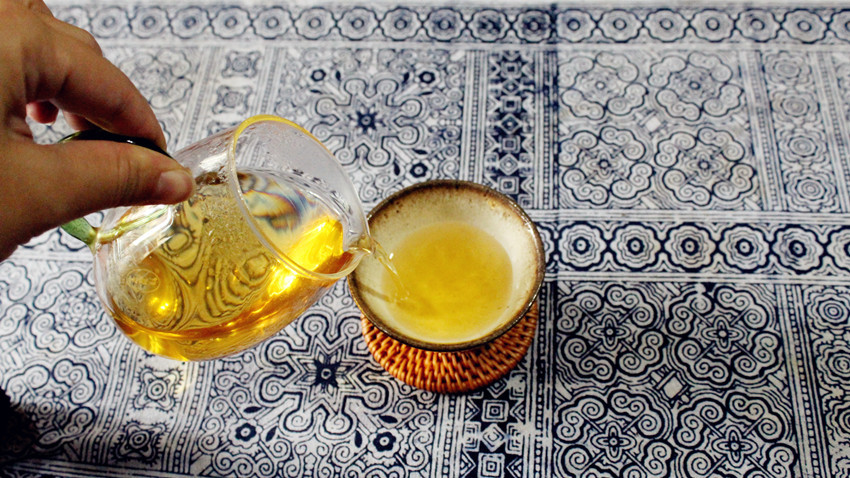
Two Types of Pu-erh Tea:Raw Sheng Pu-erh and Ripe Shu Pu-erh
Pu-erh tea is a fermented tea from Yunnan Province, China, renowned for its complex flavors and aging potential. There are two primary types of Pu-erh tea: Raw Sheng Pu-erh and Ripe Shu Pu-erh.
Raw Sheng Pu-erh Tea (生普洱茶)
What is Sheng Pu-erh?
Sheng Pu-erh, or Raw Pu-erh, is made from freshly picked tea leaves that are processed and then aged naturally. It represents the traditional form of Pu-erh tea and is known for its evolving flavors over time.
Features
- Flavor Profile: Sheng Pu-erh starts with a fresh, sometimes astringent and bitter taste, with grassy or floral notes. As it ages, it becomes smoother, richer, and develops deeper flavors like earthy, woody, and sweet undertones.
- Appearance: Dry leaves are typically green or brownish-green. Brewed tea can range from light yellow to dark amber, depending on the aging.
- Aging Potential: Sheng Pu-erh is highly prized for its aging potential, which can last for many years or even decades, during which it undergoes significant flavor transformations.
Processing
- Withering: Fresh tea leaves are spread out to wilt and reduce moisture.
- Steaming or Pan-Frying: The leaves are briefly steamed or pan-fried to stop oxidation and preserve the green color.
- Rolling: The leaves are rolled to break up the cell walls and release essential oils.
- Drying: The rolled leaves are dried to remove remaining moisture.
- Pressing: The dried leaves are compressed into cakes, bricks, or other shapes.
- Aging: The pressed tea is stored in a controlled environment to undergo natural fermentation and aging.

Ripe Shu Pu-erh Tea (熟普洱茶)
What is Shu Pu-erh?
Shu Pu-erh, or Ripe Pu-erh, undergoes a fermentation process called “wo dui” (wet piling) to speed up aging. This process produces a tea that is ready to drink soon after production, with a rich and smooth flavor.
Features
- Flavor Profile: Shu Pu-erh has a rich, smooth, and mellow flavor with earthy, woody, and sometimes sweet notes. It is less astringent compared to young Sheng Pu-erh.
- Appearance: Dry leaves are usually dark brown or black. The brewed tea has a dark reddish-brown color.
- Aging Potential: Shu Pu-erh is designed to be drinkable shortly after production, though it can still develop more nuanced flavors with extended aging.
Processing
- Withering: Fresh tea leaves are withered to reduce moisture.
- Steaming or Pan-Frying: The leaves are steamed or pan-fried to stop oxidation.
- Rolling: The leaves are rolled to release essential oils and enhance flavor.
- Wet Piling (Wo Dui): The leaves are piled in a damp, controlled environment to promote accelerated fermentation, involving regular turning and moisture addition.
- Drying: The fermented leaves are dried to stabilize the tea.
- Pressing: The dried leaves are compressed into cakes, bricks, or other shapes.
Key Differences Between Sheng Pu-erh and Shu Pu-erh
- Fermentation Process: Sheng Pu-erh undergoes natural fermentation and aging, which can take years. Shu Pu-erh undergoes an accelerated fermentation process (wo dui) to achieve a ready-to-drink tea more quickly.
- Flavor Evolution: Sheng Pu-erh starts with a fresh and sometimes harsh flavor, evolving into a smoother and more complex profile with age. Shu Pu-erh is smooth and rich from the start, with less significant changes in flavor over time.
- Appearance and Taste: Sheng Pu-erh tea starts as green or brownish-green and changes color with age, whereas Shu Pu-erh starts dark and remains rich and smooth. Sheng Pu-erh often has a brighter and more vibrant profile, while Shu Pu-erh has a deep, mellow taste.
Both types of Pu-erh tea offer unique qualities and cater to different preferences, making them valued choices among tea enthusiasts.

 7 Days GolfingTour
7 Days GolfingTour
 8 Days Group Tour
8 Days Group Tour
 8 Days Yunnan Tour
8 Days Yunnan Tour
 7 Days Shangri La Hiking
7 Days Shangri La Hiking
 11 Days Yunnan Tour
11 Days Yunnan Tour
 6 Days Yuanyang Terraces
6 Days Yuanyang Terraces
 11 Days Yunnan Tour
11 Days Yunnan Tour
 8 Days South Yunnan
8 Days South Yunnan
 7 Days Tea Tour
7 Days Tea Tour
 8 Days Muslim Tour
8 Days Muslim Tour
 12 Days Self-Driving
12 Days Self-Driving
 4 Days Haba Climbing
4 Days Haba Climbing
 Tiger Leaping Gorge
Tiger Leaping Gorge
 Stone Forest
Stone Forest
 Yunnan-Tibet
Yunnan-Tibet
 Hani Rice Terraces
Hani Rice Terraces
 Kunming
Kunming
 Lijiang
Lijiang
 Shangri-la
Shangri-la
 Dali
Dali
 XishuangBanna
XishuangBanna
 Honghe
Honghe
 Kunming
Kunming
 Lijiang
Lijiang
 Shangri-la
Shangri-la
 Yuanyang Rice Terraces
Yuanyang Rice Terraces
 Nujiang
Nujiang
 XishuangBanna
XishuangBanna
 Spring City Golf
Spring City Golf
 Snow Mountain Golf
Snow Mountain Golf
 Stone Mountain Golf
Stone Mountain Golf














